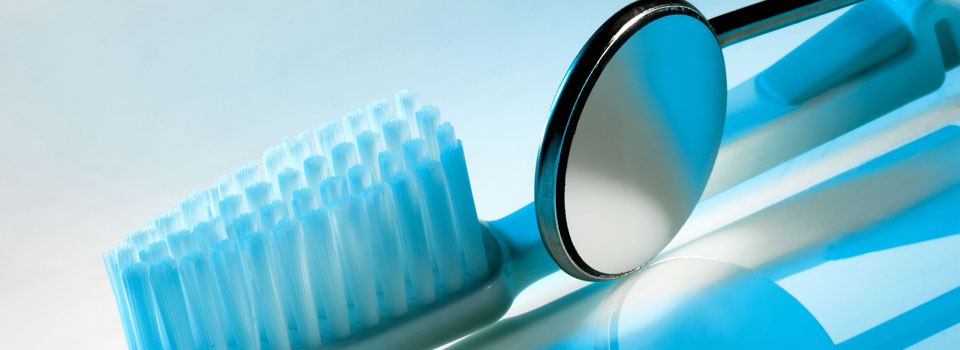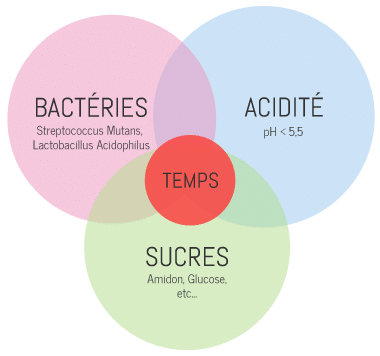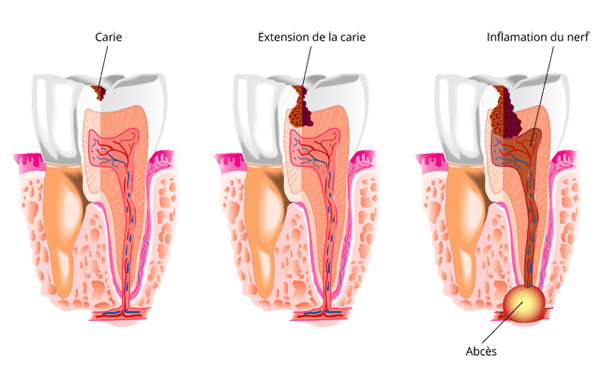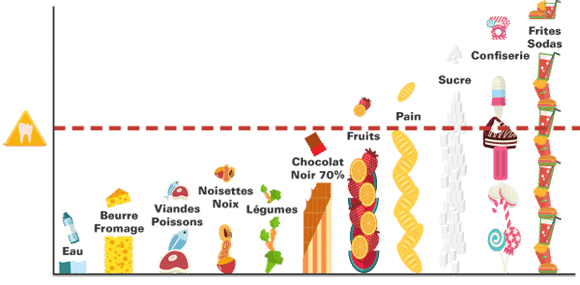
What is decay?
Few people know this, but tooth decay is an infectious disease.
According to theWHO*, it is probably the most widespread disease in the world, affecting 3.5 billion people. Depending on the country, it affects between 60% and 90% of the population. And yet it is a simple infection whose mechanisms have been known for a long time, and the bacteria clearly identified(mainlyStreptococcus Mutans and Lactobacillus Acidophilus ).
It is thought to have appeared during the Neolithic period (about 7000 years ago in Europe), probably in connection with the consumption of cereal flour. Prehistoric man was free of cavities. Caries is therefore not inevitable...
How do cavities form?
Caries is the consequence of a bacterial imbalance in the oral flora. For a cavity to form, 5 factors must come together.
- It requires the presence of certain so-called " cariogenic " bacteria such as Streptococcus Mutans and Lactobacillus Acidophilus. We all carry these bacteria (in greater or lesser quantities). These bacteria organise themselves and form dental plaque.
- Acidity is necessary, in fact below a pH of 5.5 the risk of caries is clearly increased. However, some foods are very acidic (Coca-Cola, for example, has a pH of 2.3), the degradation of food by certain salivary enzymes increases acidity, and finally, certain bacteria, such as Streptococcus Mutans, generate the acidity they need.
- Sugar (carbohydrates) is needed to feed the cariogenic bacteria. However, our "modern" diet is very rich in carbohydrates, and sticky ones at that.
- There are certain predispositions to tooth decay depending on the composition and resistance of theenamel, the quality and quantity of the saliva, etc. But what must be understood is that without bacteria, there is no decay.
- In addition to the above four factors, it takes time. That is, the bacteria must be present long enough, in an acidic environment, and in the presence of sugar for them to begin to dissolve enamel.
When these five factors are combined, cariogenic bacteria multiply and the acids produced by these bacteria will dissolve the enamel. The bacteria then penetrate the tooth. The microbes can then enter the deepest layers of the tooth (the dentin, then the pulp), dissolve the dental tissue, and destroy the tooth from the inside.


What can be done to prevent cavities?
I - Brushing your teeth.
Tooth brushing is a decisive element in the fight against tooth decay, it will allow to disorganize the dental plaque, to decrease the bacterial mass, and especially it will play on the time factor. This is why you should brush your teeth at least twice a day, so that between two brushings, the bacteria do not have time to reorganise. It is preferable to brush your teeth after meals, in order to eliminate the bacteria and the food that has been deposited during the meal, and to reduce the acidity. In addition, some toothpastes polish the surface of the enamel, which slows down the re-attachment of bacteria to the tooth.
As you will have understood, brushing acts on all the factors of caries formation, it is the "keystone of prophylaxis ". We recommend the use of electric toothbrushes combining rotation and pulsation movements, the effectiveness of which has been scientifically proven. We pay particular attention to brushing, so all our patients receive a prescription adapted to their needs. In some cases, the toothbrush is not enough, it must be supplemented by dental floss or interdental brushes.
II - Food
The diet will influence important factors: acidity, sugars, and time. It is absolutely necessary to limit the intake of soft drinks, as they are (very) acidic and sweet. Even sugar-free soft drinks are cariogenic because of their pH. If you can't do without soft drinks, it is better to drink them through a straw, in order to reduce their contact with the dental surfaces, and then drink a little water...
Nibbling on sweets, biscuits (all cereal-based products are broken down into sugars when they come into contact with saliva), etc., encourages the development of cavities because it affects the three factors of sugar, acidity and time. When we say carbohydrate-rich foods, we immediately think of sugars and sweets. But carbohydrate-rich foods do not necessarily taste sweet. The starch in potatoes, but also in cereals and flours, is just a long chain of sugar that certainly does not taste sweet. When we eat salted biscuits, crisps and chips, these are carbohydrate-rich products. The softer and stickier a food is, the more cariogenic it is.
Foods can therefore be classified according to their cariogenic potential:
- At the bottom of the ladder, water.
- Dairy products and fats (cheeses are excellent protective foods to finish a meal).
- Meat and fish.
- Nuts, hazelnuts, peanuts rich in fat to be preferred to extruded products as an appetizer.
- Vegetables.
- Dark chocolate, rich in cocoa.
- Fruit: presence of fructose and acidity. Beware of the apple crunching as a substitute for brushing.
- Bread, flour, rice and potatoes are all more cariogenic when cooked.
- Sugar.
- Confectionery, sucrose, honey.
- Cereal bars, breakfast cereals.
- Snack biscuits, chips, soft drinks and colas, bananas, sultanas.

III - Fluorine
The consumption of fluoride during childhood allows this protective element to be integrated into the constitution of the enamel in formation. Fluorinated enamel is more resistant to caries. At a local level, fluoride plays an antibacterial role and protects against caries. This is why it is recommended to consume fluoridated table salt (if the tap water is not too fluoridated), and to use a fluoridated toothpaste.
IV - Chewing Gums
Chewing gum helps to fight tooth decay, but chewing gum will never replace a good brushing, but it can be beneficial when you cannot brush your teeth after a meal. Of course, only sugar-free chewing gum should be consumed. Why is chewing gum beneficial? First of all, chewing increases the flow of saliva, which dissolves sugars, and fights acidity. This is because saliva has a number of chemical agents that help to raise the pH. The stickiness of chewing gum helps to clean the teeth and remove food residues. In addition, certain sweeteners such as Xylitol contained in certain chewing gums have a bacteriostatic effect on certain cariogenic bacteria. Finally, some chewing gums contain fluoride. So let's chew.
V - Other
Certain diseases such as diabetes, certain treatments that reduce salivation, can favour the appearance of caries. We can help these patients with a comprehensive caries assessment (salivary tests, bacterial tests, etc.), and a global treatment.
